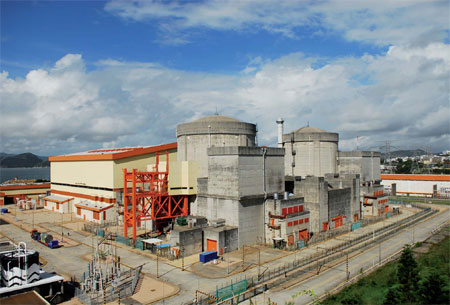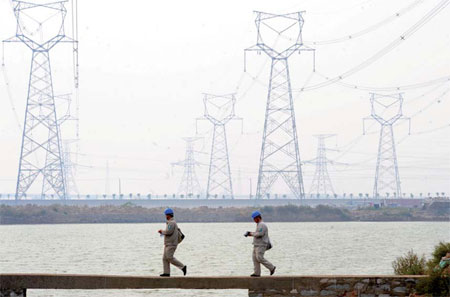Burning ambition for nuclear
Updated: 2013-10-18 09:29
By Wu Wencong (China Daily Europe)
|
|||||||||||

|
Dayawan Nuclear Power Station in Guangdong province. China will eventually need 200 nuclear power plants to meet demand, experts say. Xinhua |
Lower costs and pollution concerns main drivers for demand
Though there are still apprehensions over its future, nuclear energy remains China's best choice for clean, safe energy in the long run, experts say.
"The fear and panic associated with nuclear energy after the Fukushima disaster seem to have dissipated. Countries are now taking a more objective and rational approach toward nuclear energy," says Wang Yiren, vice-chairman of the China Atomic Energy Authority.
"Over the past four years, nuclear energy development across the world has experienced many twists and turns. But the situation has greatly changed. New nuclear power projects are coming up in the US, Russia, France and China," Wang said in his remarks at the International Ministerial Conference on Nuclear Energy in the 21st Century, held in St Petersburg in June.
Global electricity demand is expected to grow by about 85 percent or 16,000 terrawatt-hours (about four times the current usage in the US) before 2040. Much of this growth will be fueled by the industrial sector, followed by residential and commercial sectors, according to the Outlook for Energy: A View to 2040 report published by oil and gas firm Exxon Mobil. The report says that while energy consumption in China will increase substantially, it will also generate more clean energy, especially nuclear, during the same period.
Electricity generation from nuclear power worldwide is expected to increase from 2,620 billion kilowatt-hours in 2010 to 5,492 billion kWh in 2040, according to International Energy Outlook 2013, released by the US Energy Information Administration in July. The report says that European countries such as the United Kingdom, Poland and Turkey are all planning to generate more energy through nuclear power.
Clean solution
|
The transmission lines of the Tianwan Nuclear Power Plant in Lianyungang, Jiangsu province. Nuclear energy seems to be a better choice over other clean energy sources as solar and wind power face storage and transmission bottlenecks. Geng Yuhe / for China Daily |
When it comes to finding a solution to China's vexed air pollution problem, experts and environmental officials are unanimous that nuclear power is the best bet.
"China will need 200 nuclear power plants to meet demand, with four to six new projects being approved annually," says Jian Jingwen, deputy head of the equipment department at the State Nuclear Power Technology Corp. It is expected that about 10 new plants will be approved every year after 2020.
China's nuclear power industry is also one of the fastest growing industries in the world and accounts for more than 14 percent of the nuclear power generated globally every year. Of the 64 nuclear reactors under construction worldwide, 29 are in China, Zhao Yongkang, deputy director of the Nuclear Safety Management Department at the Ministry of Environmental Protection, said in July.
Nuclear power generation capacity in China will rise from 10.7 million kilowatts in 2010 to 160 million kW by 2040. The nation will also account for more than 40 percent of the global net increase in nuclear capacity between 2010 and 2040, according to the International Energy Outlook 2013 report.
China now has 17 commercial nuclear power generating units, with an installed capacity of 14.74 million kW.
By 2017, the installed capacity of China's nuclear power plants will increase to 50 million kW. This, experts, say will help China meet its goal of cutting total coal consumption to below 65 percent of total primary energy use, and raise the share of non-fossil fuel energy to 13 percent from the 2010 level of 8.6 percent, as part of its comprehensive new plan to tackle air pollution.
According to industry sources, nuclear energy may see even more impetus in the next few years as other clean energy sources like solar and wind face storage and transmission bottlenecks.
Nuclear power production around the world currently accounts for 15 percent of the gross generation of electricity, through a total of 437 nuclear power stations.
Despite the impressive numbers, misgivings about nuclear energy still persist.
Factors like operational safety, waste disposal and public opinion need to be addressed thoroughly before proceeding with nuclear power projects, says Zhao of the Nuclear Safety Management Department.
Chen Xiaoqiu, deputy chief engineer of the ministry's Nuclear and Radiation Safety Center, says China has used the most advanced technologies in its newly built and those under construction nuclear power stations.
"The core-damage frequency (a term used in probabilistic risk assessment indicating the likelihood of an accident that could damage a nuclear reactor core) of the newly constructed units is less than 1x10-5, meaning that a core damage incident is likely to take place in no less than 100,000 reactor years," Chen says.
"The large release frequency, indicating the likelihood of an accident causing a massive discharge of radioactive materials into the environment, is less than 1x10-6 per reactor year, meaning one large release incident is likely to occur in at least 1 million reactor years."
The collective amount of radiation caused by the coal fuel chain, on the other hand, is 50 times that caused by the nuclear fuel chain, says Pan Ziqiang, an academic at the Chinese Academy of Engineering and an expert on nuclear radiation prevention and control.
But these statistics have failed to end public doubts over the use of nuclear energy.
Today's Top News
Scientists requested government to plant GM crops
Travelers to Europe bypass attractions of Brussels
Li urges greater effort on reforms
'Constructive ideas' on thorny issues needed
US deal key to nabbing fugitives
JPMorgan, DOJ reaches $13b deal
As China's economy grows, so does reform call
Expanded property tax trials predicted
Hot Topics
Lunar probe , China growth forecasts, Emission rules get tougher, China seen through 'colored lens', International board,
Editor's Picks

|

|

|

|

|

|







